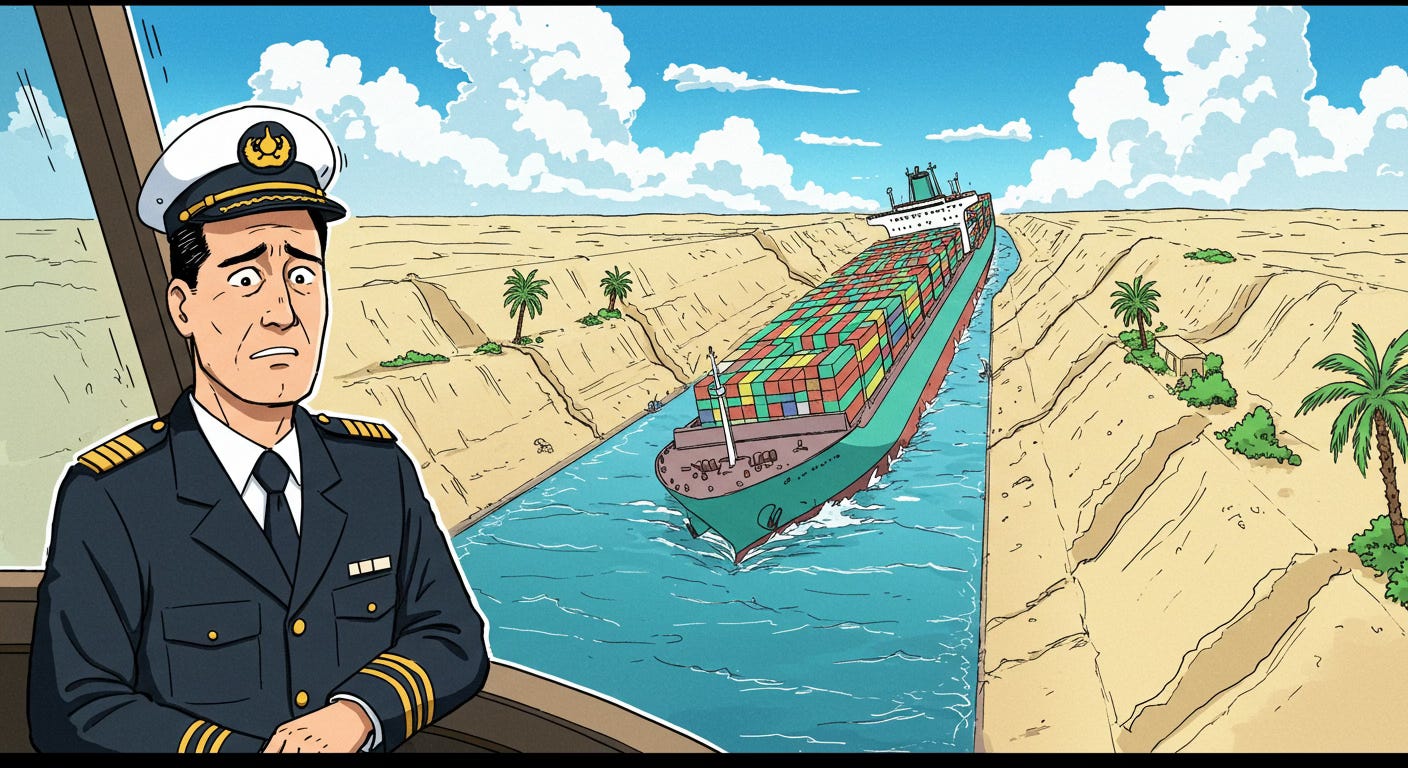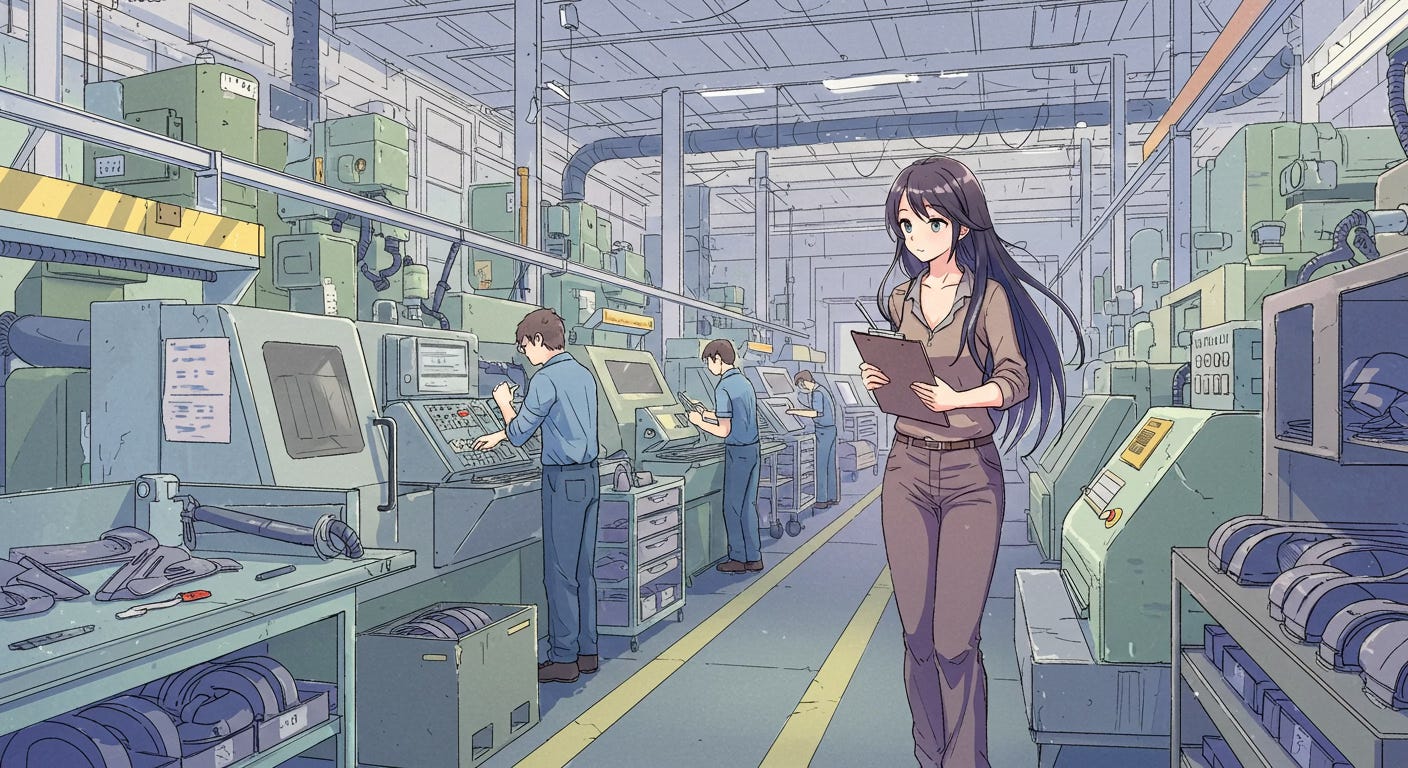The Efficiency Trap: Why Everything Your MBA Taught You About Efficiency Is Killing Innovation
In the interest of providing multiple means of engaging with this blog, below is the podcast style conversation, using our AI friends Johnny and Joanne who go into each blog post at a deeper level. Or below is the usual written format. For whatever format your current environment affords.
On March 23, 2021, a gust of wind pushed the Ever Given sideways in the Suez Canal. Within hours, global supply chains – optimised over decades for maximum efficiency – began collapsing. No redundancy. No alternatives. Just-in-time everything. Car factories shut down for want of chips. Medical supplies couldn't reach hospitals. A single ship revealed how our relentless pursuit of efficiency had created a house of cards.
But here's the uncomfortable question: How did the world's smartest companies, advised by the world's best consultants, armed with the world's most sophisticated optimisation algorithms, build systems so fragile that one stuck ship could break them?
The answer lies in a century-old choice about what "efficiency" means – a choice so fundamental we've forgotten it was a choice at all.
The Great Divergence: When Business Chose Badly
The story begins in the early 1900s with two competing visions of efficiency that would shape how we run organisations forever.
In 1906, Vilfredo Pareto introduced what became known as Pareto efficiency - the idea that efficiency isn't about maximising output, but about system states where you can't improve anyone's situation without harming someone else. For organisations, this meant considering all stakeholders, maintaining resilience, preserving optionality. Think ecosystem health, not machine optimisation.
Five years later, Frederick Taylor published "Principles of Scientific Management." Armed with a stopwatch, he studied workers like machines, eliminating "wasteful" movements. One best way to do everything. Maximum output, minimum input. Period.
Guess which version business adopted?
Taylor won because his efficiency was easier to measure. You could count widgets, time movements, cut costs, and show charts trending upward. Pareto's systemic efficiency - with its complex interdependencies and feedback loops - didn't fit in quarterly reports.
The Consultant's Amplifier Effect
Taylor's approach spawned the modern management consulting industry, creating a devastating feedback loop that continues today:
Consultants benchmark leading companies
Everyone adopts the same "efficient" practices
Industries converge on identical operating models
Constraints narrow until every player looks the same
The result? Entire industries become sitting ducks. When every taxi company runs the same dispatch system and optimises the same way, Uber doesn't need to beat them all - it just needs to think differently about the problem.
Blockbuster was incredibly efficient by 2000. Optimised store layouts, perfect inventory management, data-driven title selection. They'd Taylor'd their operations to perfection. Netflix wasn't more efficient at running video stores - they escaped the constraint entirely.
Efficient Cause vs Constraints: Why It Matters
Here's where it gets interesting. Taylor's efficiency operates on what philosophers call "efficient cause" - the billiard ball model where A causes B causes C in predictable chains. Cut costs → increase profit → shareholder value.
But complex organisations don't work like billiard balls. They work like river systems, where constraints don't cause specific flows but shape the possibility space within which behaviours emerge.
What Are Constraints, Really?
Think of rolling dice. Efficient cause thinking would focus on controlling the exact outcome - calculating roll speed, angle, and force to achieve a specific number. This is impossible in practice because tiny variations create wildly different results.
Constraint thinking recognises something more fundamental: the number of dice and their six-sided nature constrains the possible outcomes. You can't roll a seven with one die or get thirteen with two. The constraints create what complexity scientists call "affordances" - the landscape of possibilities available to the system.
You cannot cause a specific roll, but you can absolutely shape the possibility space. Use two dice instead of one, and you've changed the entire probability landscape. The constraints don't determine outcomes; they enable certain patterns whilst making others impossible.
This is how complex organisations actually function. You cannot cause innovation, engagement, or adaptation through direct management. But you can modify organisational constraints - policies, structures, incentives, cultures - to make beneficial outcomes more likely whilst reducing harmful possibilities.
Under efficient cause thinking, energy gets pushed through predetermined channels. Efficiency means minimising energy loss in transfer. The result is brittleness - the system can only handle expected flows.
Under constraint thinking, energy finds its own pathways within boundaries. Efficiency means shaping constraints so energy naturally flows toward desired outcomes whilst maintaining multiple pathways for resilience.
The Six Faces of Efficiency: Why Context Is Everything
As philosopher Alicia Juarrero argues in "Context is Everything," constraints don't just limit possibilities - they enable coherence. Context creates meaning. This insight revolutionises how we understand efficiency across different organisational domains.
Technical Efficiency - the classical input-output optimisation - works perfectly for efficient cause thinking. Ford's assembly line leveraged this beautifully: each station caused specific transformations in predictable sequences. But in global organisations, technical efficiency in one division can create unexpected inefficiencies elsewhere. When Walmart optimised its supply chain to minimise inventory, it pushed costs onto suppliers, making the entire system fragile to demand shocks.
Allocative Efficiency - getting resources to their most valued uses - straddles both worlds. Classical economics assumes resources flow to highest returns through price signals (efficient cause), but real resource flows are shaped by regulatory constraints, social networks, and cognitive biases. The constraint landscape determines where capital actually flows, not just abstract return calculations.
Dynamic Efficiency - innovation and adaptation over time - requires pure constraint thinking. You cannot cause innovation directly; you can only create contexts where innovation emerges. Bell Labs appeared "inefficient" by conventional metrics but generated innovations that created entire industries. Google's famous "20% time" constraint modification - removing the requirement that all effort flow through approved channels - allowed exploratory energy to find new pathways.
Adaptive Efficiency - evolutionary fitness in changing conditions - demands what complexity scientists call "requisite variety." Internal constraints must match environmental complexity. When organisations streamline for efficiency, they often eliminate this essential variety. Nokia was highly efficient at making mobile phones but lacked the constraint diversity to respond when the iPhone redefined the market.
X-Efficiency - operating at full potential rather than inside it - reveals how constraints interact with human psychology. Organisations’ cafeterias and leisure spaces appear wasteful through a technical lens but create "collision spaces" where random encounters generate innovations. The apparent inefficiency enables emergent properties that structured work environments cannot produce.
Systemic Efficiency - optimising the whole system including externalities - only makes sense through constraint thinking. Amazon's technical efficiency in logistics creates systemic inefficiencies: destroyed local retail ecosystems, increased carbon footprints, precarious employment. The company optimises local constraints whilst ignoring systemic ones.
The Real Cost of Getting It Wrong
Consider Toyota versus GM in the 1980s. GM pursued massive automation to eliminate labour (efficient cause) and reduce defects (effect). Technical efficiency maximised. But when markets changed, the rigid causal chains couldn't adapt.This extractive form of efficiency decimated communities, concentrating not not generating wealth. Very anti Pareto.
Toyota created constraints - kanban cards, andon cords - that allowed workers to stop production. They didn't directly cause quality; they created conditions where quality emerged from worker judgement. When disruption came, Toyota's constraint-based system adapted whilst GM's efficient-cause system crumbled.
This pattern repeats everywhere:
Wells Fargo's aggressive sales efficiency targets seemed to work until they triggered widespread fraud that destroyed billions in brand value
Boeing's decision to outsource 787 production for cost efficiency created knowledge gaps that led to years of delays and quality issues
Google's "20% time" appears allocatively inefficient but generated Gmail and AdSense by creating possibility spaces for innovation
Why Complex Systems Demand Different Thinking
Large organisations exist as nested systems - they're embedded in markets, industries, and ecosystems. When everyone pursues narrow technical efficiency:
Internal focus blinds companies to market shifts. Teams are so busy hitting efficiency metrics they miss customer behaviour changes.
Industry convergence through benchmarking means when disruption comes, it takes everyone down. The 2008 financial crisis wasn't about one bad bank - it was about all banks optimising risk the same "efficient" way.
System fragility increases even as individual efficiency improves. Just-in-time supply chains looked genius until a single ship blocked the Suez Canal.
What Leaders Should Do Instead
The most "inefficient" thing an organisation can do is optimise itself so thoroughly that it can't adapt when the world changes. That's not efficiency - it's perfecting yesterday's game whilst someone else invents tomorrow's.
True organisational efficiency in complex systems requires:
Constraint awareness - Understanding what shapes energy flows in your system. Where does effort, capital, and attention naturally flow? What barriers and channels exist?
Possibility space management - Instead of trying to cause specific outcomes, shape the space of possible outcomes. Increase the likelihood of beneficial emergence whilst reducing harmful possibilities.
Requisite variety maintenance - Keeping enough internal complexity (seemingly inefficient redundancy) to match environmental complexity. This requires accepting local inefficiencies for systemic effectiveness.
Energy flow optimisation - Not minimising energy use (classical efficiency) but ensuring energy flows toward value creation rather than dissipating in friction, compliance, or misaligned efforts.
The Measurement Trap
The tragedy isn't that we defined efficiency wrong. It's that we had a better definition all along - one that recognised organisations as living systems embedded in dynamic markets - and we chose the simpler, more brutal version because we could put it in a PowerPoint.
We've become so obsessed with measuring what's easy that we've stopped looking at what matters. Cost per unit is measurable; systemic resilience isn't. Process optimisation shows up in quarterly reports; innovative capability doesn't. Individual productivity metrics are clear; collective intelligence is fuzzy.
But in a world where the half-life of competitive advantage keeps shrinking, optimising for measurement rather than meaning is a recipe for irrelevance.
The Reflection
The question isn't whether we can measure this kind of efficiency - it's whether we can afford not to cultivate it.
Stop asking "How can we do this more efficiently?" Start asking "What constraints are shaping our possibilities, and how might we modify them to enable the futures we need?"
The organisations that survive the next decade won't be the most efficient by Taylor's definition. They'll be the ones that learned to think like Pareto - systemically, sustainably, and with genuine concern for the whole.
Your next efficiency initiative might be the most inefficient thing you can do.







